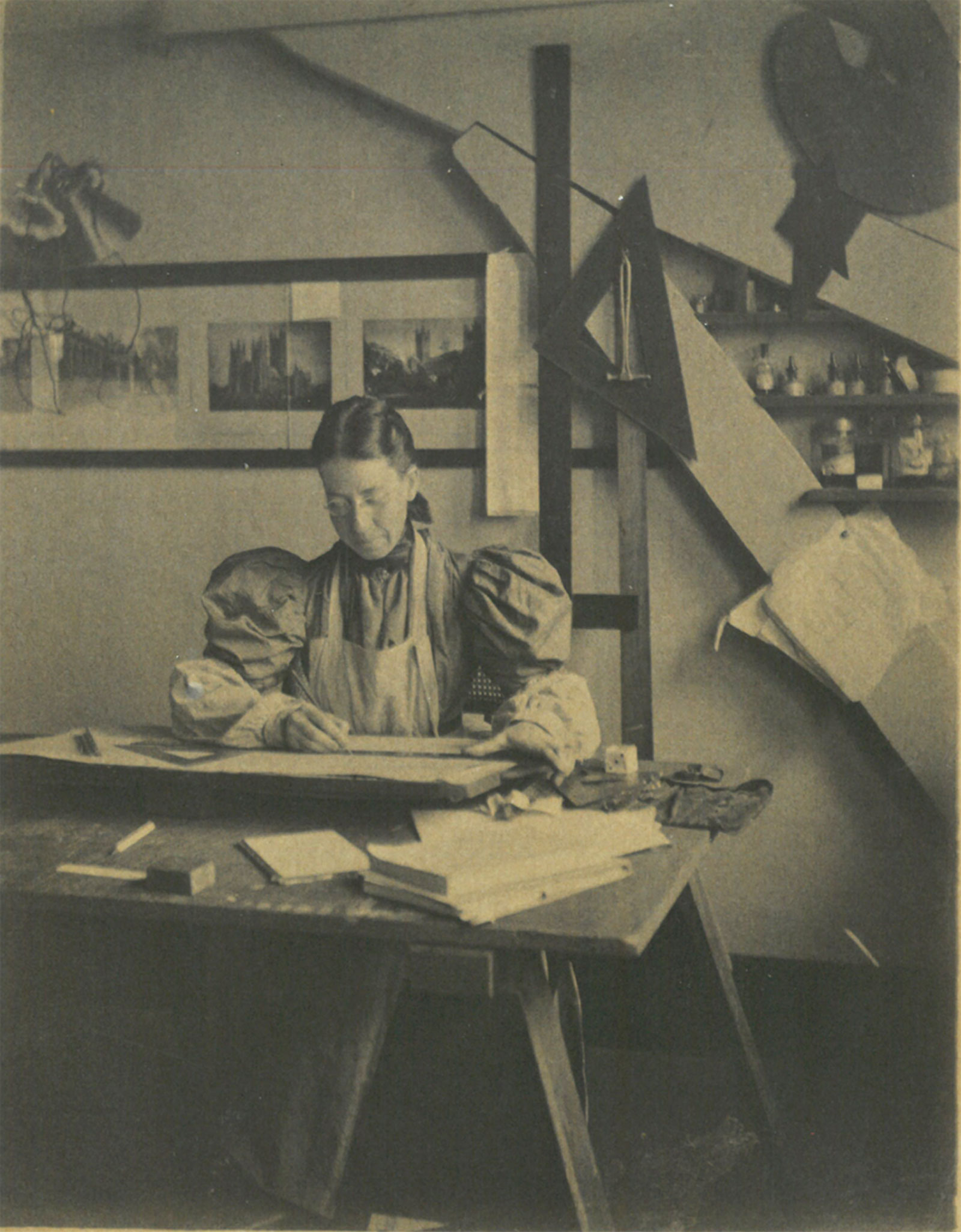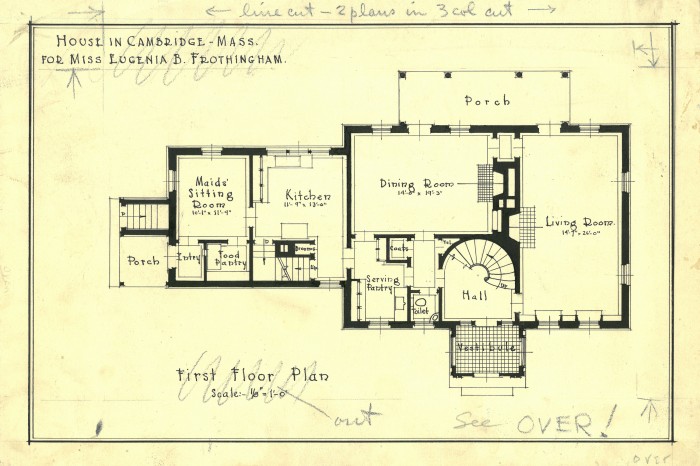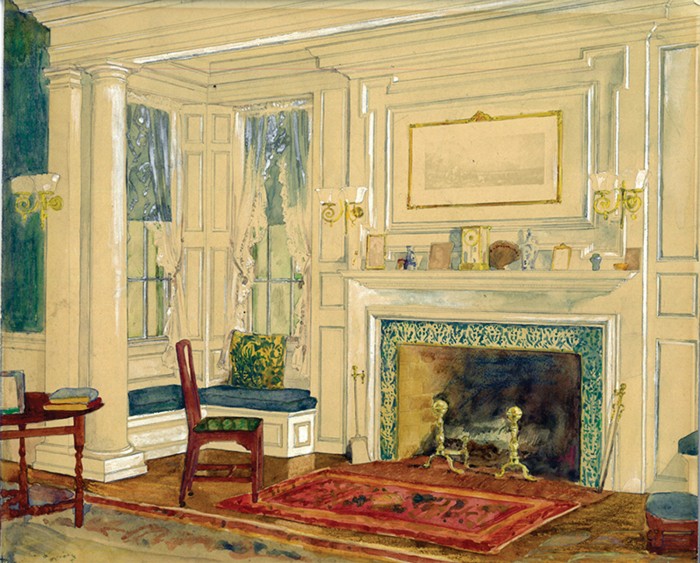Constructing a place for female architects

In 1870, luminaries gathered just north of Harvard Yard to lay the cornerstone for Memorial Hall, a High Victorian Gothic building being erected in honor of Harvard alumni who’d fought for the Union in the Civil War. Six-year-old Lois Lilley Howe happened to live across the street, and for the next seven years, considered the construction site her playground. As the enormous building took shape under her watchful eye, she spent so much time there that the workmen took to calling her “the little engineer.”
The precocious daughter of Dr. Estes Howe and Lois Lilly White Howe became fascinated with architecture, and came up with a plan for turning the straight staircase in her family’s home into one with landings. (An architect claimed it couldn’t be done, but Howe convinced the house’s next owner that it was possible, and was proved right.) And she would ultimately end up founding Boston’s first female architectural firm.
But while the Howes considered themselves part of Boston’s progressive, intellectual circles and rubbed elbows with the likes of Ralph Waldo Emerson and Henry Wadsworth Longfellow, her interest in a building career was still radical for the late 19th century. “Always interested in houses, I had wanted to be an architect but had been suppressed by my pastors and masters on the ground that I could not be an architect because I was a woman,” she wrote in a 1963 essay in Technology Review.
Not wanting to study at Radcliffe College (then known as the Harvard Annex), Howe enrolled in the School of the Museum of Fine Arts to pursue a degree in design. She spent several years attempting to work as an artist. But when her family built a new home, she found herself practically living at the construction site, and decided to seek a degree in one of academia’s newly burgeoning fields: professional architecture.
Before the 1860s, the work of gentleman architects (who met with clients and toiled at their drafting boards) and architectural engineers (who saw to the physical realization of the architects’ plans) rarely overlapped. By 1868, places like MIT were starting to offer training in both design and engineering for those who wanted to tackle every aspect of the architectural process. The young field was still primarily a men’s club when Howe arrived at MIT in 1888 as one of only two women in the architecture program, and the only one in her entering class of 66 students.
After completing the two-year “partial course” in architecture in 1890, Howe got her first taste of acclaim in 1893: second place in a national competition to design the Woman’s Building for the Chicago World’s Fair. (Fellow MIT graduate Sophia Hayden, who’d earned her four-year architecture degree in 1890, took home first prize.) Howe spent her $500 winnings on a 15-month tour of Europe with her mother and sisters before returning to Boston to start building her architectural practice.


In her essay for Technology Review, Howe wrote that just as her career was starting to take off in an office “downtown” in 1900, she was left “high and dry” by her two male colleagues. While this could easily have set back the young architect’s confidence, she charged forward, calling it “one of the best things that ever happened to me.”
Having already started to make a name for herself through commissions for friends in her social circle, Howe realized she didn’t need to rely on male colleagues’ connections to bring in work. So instead of recruiting more male architects to replace the two who’d left, she began hiring female draftsmen.
Before long, women who’d recently completed their architectural studies at MIT began flocking to the Firm, as many in Boston called her practice at the time. Alumnae sought out Howe’s practice not only for the camaraderie among the women there but because most firms run by men tended to favor male applicants. Eventually, Howe would invite two of her draftsmen to become partners. Eleanor Manning, Class of 1906, did so in 1913 and served as the firm’s engineering expert; Mary Almy, Class of 1920, took charge of business operations when she became a partner in 1926. Having partners allowed Howe to focus on design work.
The partners realized that as Boston’s only all-female architectural firm (and the second such firm in the country), they would often be expected to focus on what they (surely!) knew best: domestic architecture and design. So Howe, Manning & Almy completed many such commissions and became known for their thoughtful renovations of Colonial Revival and Greek Revival homes. (Manning referred to such work as “renovising.”) With her keen eye for design and her background in art history, Howe created meticulous designs that not only streamlined the operation of the house but paid homage to its historical elements.

Not content to focus only on renovating genteel homes, she actively sought out public architecture projects as well. During World War I, the firm contributed to the war effort by building a cafeteria at Camp Devens and by designing and building—and then volunteering at—a canteen on Boston Common that was near the firm’s Tremont Street offices. Meanwhile, Howe and her colleagues were eager to help address urban housing problems and to provide much-needed housing stock for middle-class families. As part of their practice, they began concentrating on designing smaller, more efficient homes.
In 1924 the firm was among 25 commissioned to design one of the country’s first planned communities, which was targeted to working-class families in Mariemont, Ohio. Together, Howe and Manning designed seven single-family Mariemont houses in the “English Garden” style. In the 1920s and 1930s, the firm also remodeled apartments for a slum clearance project in Lynn, Massachusetts, and submitted its small-house designs to the US Department of the Interior for its Subsistence Homesteads program, which relocated poor rural families to planned communities.
Commissions slowed during the Depression; the firm focused more on renovations than building in the 1930s, and Howe, Manning & Almy dissolved in 1937, when Howe retired. By that time, though, the firm had completed a formidable 426 commissions. Manning and Almy went on to found firms of their own, and Howe remained in Cambridge to pursue her interests in historical architecture and preservation. She gave frequent talks at the Cambridge Historical Society up until her death in 1964, just 12 days shy of her 100th birthday.
“Small commissions led to large ones,” she wrote in Technology Review. “And while we never grew fat and rich on small houses we generally had good jobs.”
Keep Reading
Most Popular
Large language models can do jaw-dropping things. But nobody knows exactly why.
And that's a problem. Figuring it out is one of the biggest scientific puzzles of our time and a crucial step towards controlling more powerful future models.
How scientists traced a mysterious covid case back to six toilets
When wastewater surveillance turns into a hunt for a single infected individual, the ethics get tricky.
The problem with plug-in hybrids? Their drivers.
Plug-in hybrids are often sold as a transition to EVs, but new data from Europe shows we’re still underestimating the emissions they produce.
Stay connected
Get the latest updates from
MIT Technology Review
Discover special offers, top stories, upcoming events, and more.